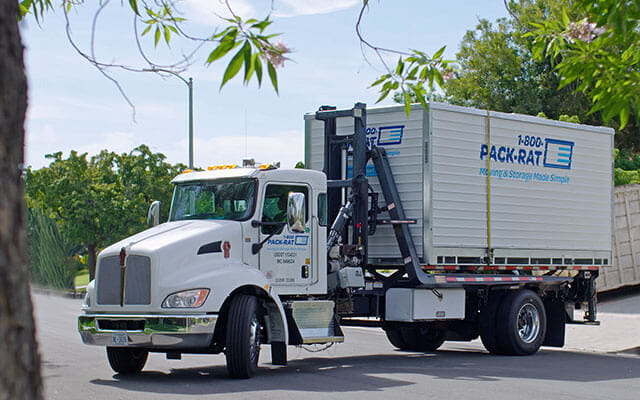
When it comes time to move bulky or unconventional items like large appliances and equipment, the process may appear overwhelming. To alleviate your concerns, 1-800-PACK-RAT has developed a comprehensive guide to help you learn how to prepare and move appliances and equipment like a moving professional! One essential tool at your disposal is a moving dolly, as it can significantly simplify the process of transporting appliances and other equipment.
Preparing Your Kitchen Appliances and Heavy Items for Your Move
When getting ready to sell your home, one important decision is whether to relocate the appliances, including small appliances like coffee makers and blenders, to your new home, sell them at a yard sale or online, or include them as part of the home sale. It is important to note that dishwashers, heating/cooling systems, and the stove/oven are typically included with a home when sold, so that decision is usually made for you. Selling appliances before your move could save significant time and money since these large and often cumbersome items can be challenging to move. Plus, if you have been considering upgrading your appliances, you now have a prime opportunity to earn money by selling them as an investment toward new appliances for your future home. You can sell on sites such as Facebook Marketplace or Craigslist.
For all appliances you plan to move, clean everything using a damp cloth before it goes into a portable storage container, especially if it will stay there for any time before unpacking. If you store something while it is dirty or has grime or crumbs, it will only be dirtier when you unpack it one, two, or twelve months later. All appliances and equipment should be as clean and dry as possible before storing them away during your move to prevent odors. Anything wet will start producing and spreading mold and mildew while in storage.

Certain things in your home or garage are considered hazardous when moving and should not be placed in a portable storage container or any other competing moving solution. You must set those things aside well before your move. This list includes aerosol cans, fertilizer, pesticides, charcoal, disinfectants, ammunition, fireworks, pool cleaning chemicals, paint thinner, fire extinguishers, car batteries, gas tanks, and gas cans. This also includes anything that is considered an illegal substance. Always consult with the experts at 1-800-PACK-RAT if you are unsure about a particular item, but a good rule of thumb is that if it is combustible or highly flammable, do not place it in your container.
Before you begin moving your fridges or standalone freezers, start cleaning out or eating the food stored inside before you begin the defrosting process. You can consider giving these to neighbors or donating them to a local food bank if they accept such items before moving or disposing of them.
How to Pack a Refrigerator or Freezer
It is often overlooked by movers, given everything going on, but your fridge contains a lot of water that must be completely drained prior to moving it. Begin by unplugging the refrigerator or freezer and disconnecting the waterline several days before moving day to allow ample time for defrosting. On moving day, wipe out any moisture from the refrigerator or freezer - any moisture left can turn into mold or mildew buildup. Measure the doorways to ensure you have enough room to move your fridge out without damaging your home - either have professional moving assistance ready to help on your moving day, or have at least one person help move and another spot your path for you as you move it.
Additionally, having an appliance dolly on hand will prove invaluable for moving your refrigerator. You can purchase or rent one if you're doing a DIY move.
How to Pack a Washing Machine & Dryer
Like your fridges and freezers, your washing machine must be completely drained prior to moving to avoid issues with mold and mildew. Before moving day, run a complete rinse or cleaning cycle for your washer to effectively eliminate any lingering detergent residue. When preparing your dryer, remove any accumulated lint from it, as lint can become combustible under certain circumstances. To prepare the appliances for moving or storage, turn off cold and hot water valves from the wall and place plugs, wiring, drained and dry hoses, and any removable parts within the appliances or in a separate bag clearly labeled for later.
How to Pack an Oven & Range
To prepare your oven for moving, remove and pack any items stored in your oven and initiate a self-clean cycle several days before moving day to remove any buildup on the inside of the oven. If you have a gas stove, it is essential that you contact your gas or propane provider to help safely shut off the gas line going into your home if you don't have a manual shut-off valve to shut off the gas and disengage the piping.
Additionally, clean any areas where grease may have accumulated, and ensure to dispose of any perishable food nearby, ensuring the entire unit is ready for transport. Electric stoves can be unplugged from the power source. Secure the stove knobs with tape to prevent them from becoming loose during transit.
How to Pack a Microwave or Toaster Oven
To prepare your microwave oven and toaster oven for moving, start by removing and securely wrapping the glass turntable from the interior. Diligently clean and thoroughly dry your microwave oven, then pack the main unit in its original box if still available. If the original box is unavailable, locate a box slightly larger than the microwave oven and place it inside with plenty of padding to fill in any empty spaces and prevent movement during transit.
For toasters and toaster ovens, clean any debris or crumbs out as much as possible. For toaster ovens, consider running a cleaning cycle if your unit has one; otherwise, use a very light soap mixture to clean the inside of it. This will help remove any grease stains, and it will be one less thing for you to do at your new home.
How to Pack a Grill
Before packing your grill, dispose of unused charcoal or remove the propane tank. Note that propane tanks are typically not allowed to be stored and moved inside any moving solution due to their combustible nature. Check with 1-800-PACK-RAT or your mover to learn how to move such items correctly. Detach any removable components from the grill and pack them separately to minimize the risk of damage and shifting during transit. If you have any grill plates, flavorizer bars, or other accessories that can come loose and get jostled around, consider removing, bagging, or boxing them separately to avoid damage.
How to Pack Lawn Equipment
To safely pack your lawn equipment and lawn tools for relocation, be sure to secure all items and any accessories that go along with them. This includes weed eaters, tools, etc. Please note that, like with grills and propane tanks, almost every moving company strictly prohibits the moving of equipment that has gasoline or oil inside it.
To learn more about what you can and cannot move in your container or how to make certain items compliant with our rules and guidelines, give us a call today, and one of our helpful moving representatives will assist you.
How to Pack Tools
Organize your loose hand tools by packing them into sturdy, small containers that support their weight. For valuable tools, take extra care to wrap them individually in soft rags or towels to keep them in pristine condition, including ensuring smaller pieces are adequately secured. Use the right moving supplies for enhanced protection to provide suitable coverings for any tools and equipment with sharp edges or blades to prevent accidental injuries or damage.
What Is the Best Way to Pack Kitchen Appliances for Moving?
First, pack kitchen appliances for moving, thoroughly clean and dry each item. If available, use original boxes; otherwise, use sturdy, heavy-duty boxes with cushioning materials like packing paper, bubble wrap or towels. Securely tape the boxes and label them clearly to ensure safe transport and easy unpacking at your new home.
Pack Your Portable Moving and Storage Container Wisely
When loading your portable moving and storage container, pack heavier items, such as appliances, accessories, and furniture, at the bottom of the box and your moving boxes. For your heavy items, be sure to distribute the weight evenly across the floor of the container—do not overload one side of the container with all heavy items. This can cause the container to sway during transport, damaging our vehicle, the container, and your belongings.
Think vertically, as that is typically an underutilized space in a storage container. Pack your items from floor to ceiling, creating wall-like layers. Fill any open spaces with boxes and other small items like wine glasses to provide stability. Odd-shaped items can go on top of boxes or near the doors. Furniture pads, blankets, and pillows work well to cushion fragile items. Taking the extra time to pack your storage container carefully will make unpacking more manageable and keep your belongings secure while being transported and stored. Get more information on packing your container like a professional here.
Are There Specific Packing Materials Recommended for Fragile Kitchen Appliances?
Yes, when packing fragile kitchen appliances, it's essential to use bubble wrap, packing paper, and sturdy boxes. Additionally, foam peanuts or air pillows can provide extra cushioning. Ensure each appliance is securely wrapped and labeled to prevent damage during transit and make unpacking easier.
Use 1-800-PACK-RAT Portable Storage Containers for Your Upcoming Move

We know it can be hard to determine how many containers you might need. No home or move is the same, and everyone has different needs. We offer a space calculator to help you estimate the number of portable storage containers you might need to move or store your belongings, and a weight estimator sheet you can download for additional assistance. If you still have questions, give us a call and let us know what you need. We aim to make the process as simple as possible!
1-800-PACK-RAT's portable moving and storage containers offer tons of flexibility with a predictable cost for all your local and long-distance moving needs, as well as your short- and long-term storage needs. After one of our professional drivers drops off a container at your door, you can pack your belongings at your own pace for as long as you need. With 80 secure nationwide locations and counting across the continental United States, you can count on us to get your stuff to you or store it safely and securely for as long as you need. When ready, we will redeliver your storage container or move it to your next destination.
1-800-PACK-RAT makes moving and storage simple – give us a call or get a free quote today to see how we can help you!